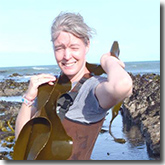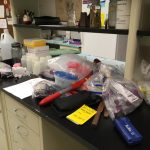A few weeks ago, I highlighted the artistic and scientific variety of illustrations of Metridium senile. These images were on my desk because Metridium is on our minds a lot these days as the focus of the dissertation research of EEOB PhD student Heather Glon. Heather aims to address one of the persistent problems with this widespread and highly variable anemone: whether the name Metridium senile is being used for a constellation of related but distinct species or whether it represents a single, cohesive circumpolar species.
Answering this question requires sampling across the broad range of this species, analyzing DNA from multiple individuals within populations, and comparing morphology and micro-anatomy. Although our partner museums, like the Smithsonian National Museum of Natural History, American Museum of Natural History, and California Academy of Sciences, hold collections that can help solve this puzzle, none of these collections have sampled at the depth we require and the vast majority of the samples in museums are preserved in ways that complicate DNA analysis. With only a few years to amass the data needed for a dissertation, we have no choice but to spend spring break on the road, searching for Metridium along the California coast.
- We will sample along the California coast from Bodega Head to Morro Bay.
- This is the sampling gear we need to collect anemones
After nearly 10 weeks in classes, this chance to be outside in the field, focusing on research is a welcome change of pace for both me and Heather. The recent rains in California and generally high low tides of the coming week means that we’ll work mostly from floating docks, searching for small pink anemones among the sea squirts, hydroids, and worm tubes coating the floats and pilings. Our travels will take us from Bodega Head to Morro Bay, with detours through Monterey, Half Moon Bay, and Marin. Follow us on Facebook and Instagram, or check back here on Friday for a wrap up of our efforts.
 About the Author: Dr. Meg Daly is Professor in the department of Evolution, Ecology and Organismal Biology, director of the Museum of Biological Diversity and leads the laboratory of marine invertebrate diversity at OSU. She and her students study systematics of cnidaria, sea anemones, jellyfish and their like.
About the Author: Dr. Meg Daly is Professor in the department of Evolution, Ecology and Organismal Biology, director of the Museum of Biological Diversity and leads the laboratory of marine invertebrate diversity at OSU. She and her students study systematics of cnidaria, sea anemones, jellyfish and their like.

